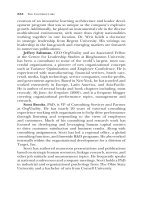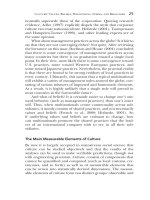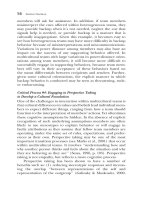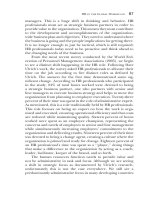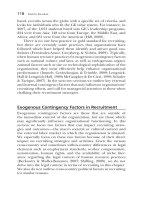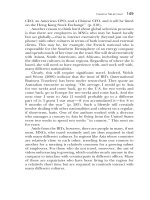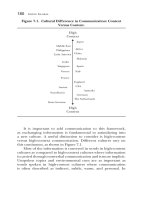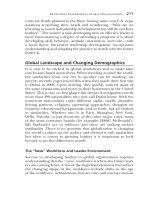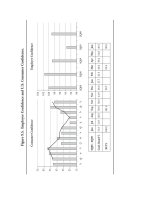Going Global Practical Applications and Recommendations for HR and OD Professionals in the Global Workplace J-B SIOP Professional Practice Series by Kyle Lundby, Jeffrey Jolton and Allen I. Kraut_6 doc
Bạn đang xem bản rút gọn của tài liệu. Xem và tải ngay bản đầy đủ của tài liệu tại đây (466.17 KB, 28 trang )
HR in the Global Workplace 103
The challenge is that often you are not just dealing with the local
language but the local dialect. For a lower-skilled, less-educated
employee population, ensuring that the level and meaning are
captured is a challenge.
One way to address this issue is to have in-country employees as
reviewers to translate and retranslate, or validate, the message con-
tent. The original translation can be completed by a translation
service (these services tend to employ local country nationals).
The translation should be followed with a back-translation by
an in-country employee to ensure that it matches to the orig-
inal meaning. The original translation can also be completed
by an in-country employee, however the back translation is key
and should be performed by a different in-country employee.
Nuances in languages are usually seen here. It is possible to say
something multiple ways—all of which may be correct. The deci-
sion then is which translation to accept. Sometimes it is best to
accept the employee translation over the translation service as it
assumes employee buy-in to the process and the creation of an
invested employee stakeholder. Translation and retranslation take
a great deal of time. Expect some back and forth as translations are
validated. This does take time and should be explicitly planned
for in any project plan.
It is critical that messages are not ‘‘lost in translation’’ and
that the intended message or purpose of the initiative is what
is communicated in the end. One of the authors was involved
in a situation where a translated performance evaluation form
implied that the goals and objectives were optional and not
necessarily formal or enforceable (oh, the subtleties of language).
In this European country it was actually easier to operate this
way because if goals were optional you did not need to get buy-
in or approval from the unions or work councils. However, it
was critical to the performance and success of the organization
that employees understood their job and its required goals and
associated objectives.
Legal Issues
As programs are designed, it is always easy to assume that they will
work everywhere. Even with thoughtful due diligence and global
representation, sometimes country-specific regulations or legal
104 Going Global
issues may stand in the way. Assumptions tend to get challenged
in a global environment. A case in point—one of the authors was
responsible for creating a global employee relief fund. The fund
would be used for employees in economic need after a disaster
(natural or otherwise) resulting in a loss or hardship. In a global
organization, a tsunami in Asia not only affects local employees
but it also provokes compassion from fellow employees all around
the world. The goal of the program was to raise funds through
donations from employees, with a match from the organization.
It would seem easy enough in concept, however, not so easy in
implementation. It was discovered during the implementation
phase that some countries do not allow money to actually leave
their country, thereby making donations impossible to collect.
China could solicit donations and raise money from employees,
but the money could not leave the country and be part of the
‘‘global’’ account. The money had to stay in China and could be
used only for Chinese employees in need. Technically this was
in conflict with the mission of the program where the goal was
a global fund to which all employees could contribute and also
apply for a relief fund grant. In addition, though donations to
charities are considered tax deductible in most countries, this is
not universally the case. Local tax laws had to be identified and
communicated with the rollout of the program. which created an
added level of complexity.
Ethics and Compliance Issues
The economic turbulence of 2008 and 2009 has shed new light
on ethics and compliance issues. Whereas almost all multina-
tional organizations have ethics and compliance programs (as
mandated by their local country’s laws), cultural issues affect how
they actually operate. In order to develop and implement global
ethics programs and hotlines, organizations need to address some
challenges, including how to communicate a consistent business
ethics policy in many languages. If organizations areimplementing
a global hotline, the hotline services must be localized to conform
to local language and cultural norms. Another development in
recent years is that organizations now have to address interna-
tional data privacy laws, including whistleblower guidelines and
HR in the Global Workplace 105
data transfers (EthicsPoint, 2009). Data privacy laws have made
general business as well as HR-specific operations more challeng-
ing. Outside the United States, multinational organizations must
tend to the often conflicting requirements of local governments.
France, Belgium, Spain, Canada, Germany, Ireland, and Japan
are just some of the countries with differing data privacy laws that
must be addressed. Global organizations must be aware that many
cultures are extremely wary and some are averse to the practice
of whistleblowing. In addition, what is considered unethical or
illegal behavior can vary widely, further complicating attempts to
adopt a uniform ethics program. The data protection require-
ment and language barrier in many multinationals can make
it very difficult to capture information about, and investigate,
possible misconduct.
Future of Global HR Management
With the economic events of 2008 and 2009 behind us, we wonder
about the future and the implications for global HR management.
Shifting Role of Human Resources
The human resourcesbusiness partnermodel, asdescribed earlier,
has to adapt to meet the changing business challenges which will
continue to evolve,for the immediate time being, with uncertainty.
However, all this uncertainty can be to an HR professional’s
advantage. HR can define the future based on predictable trends
(such as demographics or business growth) but it can also step
up to the challenge of defining its own future. HR has evolved
over the last several decades as businesses have evolved. The
administrative and transactional roles of the past have given way
to a strategic business partner model. Some are advocating that
the next evolution of the role will take us to an internal consultant
model (Vosburgh, 2007) where HR is not pushing an HR agenda
but instead helping clients in their respective businesses to solve
difficult business problems.
Globally, the HR function is in different places in its evolu-
tion. In many of the Asian countries we still see remnants of a
transaction-based HR function as they are still technically in the
106 Going Global
first generation of a free enterprise system. Multinational orga-
nizations need to ensure that their global HR professionals have
the skill sets to support their organizational clients for the future.
Creating world-class HR talent globally should be a top priority of
every chief human resources officer.
Emerging Economies
As global markets expand, what are the implications for
human resources? Will there be special focus on the BRIC
economies—Brazil, Russia, India, and China? For the last several
years these countries have been identified as emerging economic
powerhouses and, for many multinational organizations, these
countries have been a focus for economic growth. It is predicted
that by 2035, the combined gross domestic product (GDP) of
these four countries will become bigger than the G7 (Kowitt,
2009). This has huge human resource implications as HR
professionals will have to select, develop, and retain employees
in these emerging economies for years to come. They will have
to balance expatriate staffing, which will be necessary for the
exploding growth, with cultivating and nurturing local talent
development.
Our growing global service economy continues to put the
spotlight on talent. Talent acquisition, retention, and develop-
mentareevenmorecriticalinaserviceeconomythanina
traditional manufacturing economy.
Identified Needs
A survey of over 4,700 executives by the Boston Consulting Group
(2008) found that managing talent and improving leadership
development were consistently top concerns globally. In North
America, survey participants perceived the critical challenges to be
managing talent and demographics, improving leadership devel-
opment, managing work-life balance, and transforming HR into
a strategic business partner. In Latin America, the top two future
HR challenges identified were managing work-life balance and
managing talent. In Europe, managing talent and demograph-
ics emerged as key challenges. In Africa, executives identified
HR in the Global Workplace 107
managing talent, work-life balance, globalization, and diversity
as major future challenges. The key HR challenges in Emerg-
ing Asia (China and India) were identified as managing talent,
improving leadership development, becoming a learning organi-
zation, and managing work-life balance. Executives in Established
Asia (Singapore, Japan, South Korea) were primarily concerned
with managing globalization, talent, and improving leadership
development. In the Pacific Region, executives named managing
talent, improving leadership development, managing demograph-
ics, managing change, and cultural transformation as critical HR
challenges. We are beginning to see some shift in priorities as
now managing the work-life balance of employees seems to be
gaining importance, especially in countries where work councils,
or unions, play a huge role in the labor market.
Deglobalization
Given recent world events one might even argue that we are
seeing a shift to a deglobalization or relocalization. Sustainability
is not only a media topic and popular cause, but it has also
become embedded in most organizational strategies. Individuals
and organizations are noting and using local resources versus
a global supply chain, as evidenced by trends such as the slow
food movement. This has implications for talent resources as well.
Though it is still too early to conclude whether the pendulum has
swung in the other direction, if we do begin to see an increased
emphasis on localization, then we will probably also begin to see a
decrease in talent mobility with increased emphasis on identifying
and growing local talent.
Human Resources as a Decision Science
For human resources to continue to evolve, we need to maintain
focus on human capital as the differentiator of organizational
success. A key correlate is the ability to measure success. The
successful HR function of the future will have the ability to
measure key metrics and become more of a ‘‘decision science’’
(Boudreau & Ramstad, 2007) thereby measuring its impact on
business outcomes rather than HR activities. The focus needs to
108 Going Global
shift from the services that HR provides to the business decisions
that HR informs and supports.
Human Resources professionals will also become more aware
of capital markets and the role that intangible assets such as
human capital play in sustaining those markets. The investor
community is now interested in such HR practices as succession
planning, leadership development, corporate culture, and execu-
tive compensation as data points in buy-or-sell decisions (Ulrich
& Brockbank, 2009).
In conclusion, if HR is successful in harnessing the strengths
and talents of its employees, it stands to reason that the enterprise
will be successful. Understanding our global complexity, the value
of human capital, and the value that the human resources function
can provide to meet the business challenges can create an exciting
future. Organizations are not productive or profitable if they do
not have the right talent in the right roles aligned with the business
strategy. Human resources professionals are the best positioned
to create this alignment and help an organization succeed by
bringing its business strategy to life globally.
References
Boston Consulting Group (2008). Creating people advantage: How to address
HR challenges worldwide through 2015.
Boudreau, J., & Ramstad, P. (2007). Beyond HR: The new science of human
capital. Boston: Harvard Business School Publishing.
Christensen, R. (2006). Roadmap to strategic HR. New York: American
Management Association.
Corporate Leadership Council (2009). Building HR business partner
capabilities in continental Europe.
EthicsPoint (2009). www.ethicspoint.com.
Hewitt Associates (2009a). Managing HR on a global scale: Findings
from Hewitt’s 2009 Global HR Study.
Hewitt Associates (2009b). Foot on the gas: Managing human resources
in the Middle East.
Hofmeister, J. (2005). Global and local balance in human resources
leadership. In Losey, M., Meisinger, S., & Ulrich D. (eds.), The
future of human resource management. Hoboken, NJ: Wiley.
Kowitt, B. (2009). For Mr. BRIC, nations meeting a milestone. CNN-
Money.com, June 17, 2009.
HR in the Global Workplace 109
Rucci, A. J., Kirn, S. P., & Quinn, R. T. (1998). The Employee-customer-
profit chain at Sears. Harvard Business Review, 76, 1, 95–112.
Ulrich, D. (1997). Human resources champions.Boston:HarvardBusiness
School Press.
Ulrich, D., & Brockbank, W. (2009). The HR business partner model:
Past learnings and future challenges. People and Strategy, 32,2,5–7.
Vosburgh, R. M. (2007). The evolution of HR: Developing HR as an
internal consulting organization. Human Resource Planning, 30,3,
11–23.
World Federation of Personnel Management Associations. (2005). Survey
of global HR challenges: Yesterday, today and tomorrow.
Yeung, A. (2005). Becoming business partners in Chinese firms: Chal-
lenges and opportunities. In M. Losey, S. Meisinger & D. Ulrich
(Eds.), The future of human resource management. Hoboken, NJ: Wiley.
PART 2
Attracting
and Selecting
Employees in the
Global Workplace
CHAPTER 5
Recruitment in a
Global Workplace
Mukta Kulkarni and Mathian Osicki
The only thing worth more than a bright new idea is a
bright new hire.
—Nakache, 1997
Attracting human resources to an organization not only deter-
mines the future composition of the organization’s workforce,
but also the long-term ability of the organization to meet its
strategic goals. A good recruitment procedure can function as a
sieve, to filter people from the available talent pool. Attracting
the right candidate is important not only in booming markets
where organizations compete intensely for scarce talent, but also
in recessionary markets where organizations have to sift through a
large number of applicants who are vying for relatively fewer jobs.
An Employment Management Association report indicates
that, on average, organizations spend $1,000 recruiting a nonex-
empt employee, about $7,000 for an exempt employee, and over
$23,000 forexecutive-level employees in the external labormarket.
Recruiting efforts therefore have to be targeted toward attracting
the right candidate, not only given financial implications, but also
because they feed into consequent selection processes. If recruit-
ing strategies don’t help identify a sizable and suitable pool of
talent, even the most accurate selection process will be of little or
no use (Fisher, Schoenfeldt, & Shaw, 2006).
113
114 Going Global
Despite the importance of the recruiting function, a recent
survey of 50 CEOs of global organizations paints a grim pic-
ture. This survey indicates that even for top management-level
recruitment, strategies are ad hoc, vague, and heavily reliant on
subjective evaluations. The consequence is that about a third of
new hires leave after three years of being with the organization.
What is more surprising is the fact that most CEOs do not see the
situation as it is (Fern´andez-Araoz, Groysberg, & Nohria, 2009).
Suboptimal recruitment, and the consequent unavoidable subop-
timal hiring, especially at strategic levels and for key positions,
can cause serious financial setbacks for an organization or, worse,
ruin it. Sometimes organizations search too narrowly and try to
find candidates from within their own network, only to realize
too late that their decision was flawed (Fern´andez-Araoz, 2007).
Indeed, a study by the Center for Creative Leadership shows that
one out of four executives selected is the only one considered
(Fern´andez-Araoz, Groysberg, & Nohria, 2009). This may well
have been the case with appointing Jill Barad at the helm of
Mattel, or Douglas Ivestor at the helm of Coca-Cola. Both were
asked to leave after about two and a half years (Charan & Colvin,
2000; Morris, et al., 2004). Could the organizational stories have
been different had they cast a wider net and attracted and sifted
through other candidates?
Importance of Casting a Wide Recruiting Net
Traditionally, organizations could scan their local environments
for a relevant supply of talent and be reasonably satisfied with
the results. Today though, given uneven employment growth
(International Labour Organization, 2009), globalization, and
competition, organizations have to broaden their scan to include
international environments (Schuler & Tarique, 2007). For
example, given increased technological sophistication and
opening up of markets, companies like Dell, Sony, Apple,
Zara, Nike, to name a few, have had to develop a global talent
pool and conduct recruiting globally to service expanding
markets (Dessler, 2008). To make matters more complicated for
organizations, much of the global talent pool now lies outside
of the United States and Europe. Thirty-three million young
Recruitment in a Global Workplace 115
professionals now live in 28 low-wage countries (Despeignes,
2005), and this talent is not uniform in availability. India and
China, for example, were predicted to face serious skilled
labor shortages by the end of 2009 (Farrell & Grant, 2005;
NASSCOM, 2006). Further, available skill sets and numbers do
not match organizational requirements in certain parts of the
developing or growth economies (Guthridge, Komm, & Lawson,
2008; International Labour Organization, 2009), especially for
managerial positions (Ready, Hill, & Conger, 2008).
Given the global nature of business today, organizations have
to create very specific and effective recruitment efforts to build
a deep reservoir of global as well as local talent to staff all their
organizational levels (Guthridge, Komm, & Lawson, 2008). To
address these challenges, global organizations such as Procter &
Gamble have mapped a global supply-chain process to obtain tal-
ent. At the country leader level at Procter & Gamble, for example,
there are about 300 executives who come from 36 countries, and
50% are from outside the United States. The top 40 executives of
Procter & Gamble come from 12 different nations, and 45% are
from outside the United States (Ready & Conger, 2007).
Consider also the example of Renault-Nissan. In 1999, the
top brass of Nissan, then in financial trouble, decided to partner
with Renault and chose a non-Japanese COO from Renault to
transform the organization. The COO was Carlos Ghosn, a Brazil-
born French-Lebanese businessman. It was a bold decision for
the Japanese company, which usually recruited only Japanese
executives, and one that transformed the ailing company into a
successful one (Millikin & Fu, 2005).
It is not only large or multinational for-profit organizations
that have to cast a large recruiting net to leverage the globally
dispersed talent and overcome regional skill scarcity. Consider
the involved and successful recruiting strategy followed by Sinai
hospital in Baltimore, Maryland. This not-for-profit health care
organization reaches out to nurses in the Philippines, spends
time explaining their mission and work, and, after determining
a fit, invites them to join their campus. This strategy has helped
them tremendously in meeting talent demands. These examples
demonstrate how casting a wide recruiting net can effectively fill
a void that a narrower one may not address.
116 Going Global
Scope and Outline of the Chapter
In this chapter, we draw upon recruitment research and organi-
zational examples to outline various contingencies that managers
should consider when undertaking recruitment initiatives, and
offer specific recommendations for recruiting effectively in the
global workplace. We define recruiting as a process of finding and
attracting the right candidates and encouraging them to apply
for certain positions (Bohlander & Snell, 2004; Dessler, 2008).
Given our scope, we do not detail internal versus external sources
of recruitment, content and delivery of recruitment messages,
effects of recruiter characteristics, or timing of recruitment initia-
tives. Comprehensive summaries and reviews on these topics can
be found elsewhere (for example, see Barber, 1998; Bohlander &
Snell, 2004; Breaugh, 2008; Dessler, 2008).
The chapter is structured as follows. First we discuss the notion
that various contingencies have the potential to influence recruit-
ing strategies, and how organizations have to be aware of these
contingencies. In the next section we specifically elaborate on
external as well as internal contingencies that have an impact on
recruiting. In each section we draw upon research and organiza-
tional examples to identify key lessons and recommendations for
managers. The chapter is broadly summarized in Table 5.1.
Contingencies to Consider When Recruiting
Organizations function within an external societal and global
context as well as an internal organizational context. Both these
exogenous and endogenous contexts serve as contingencies that
influence human resources practices in general and recruitment
in particular. Key exogenous or external contingency factors
include the legal, societal or cultural, political, and labor market
contexts. Key endogenous or internal contingency factors include
the size, age, technology, and structure of an organization (Jack-
son & Schuler, 1995). To deal with both kinds of contingencies,
global organizations typically follow one of three approaches in
terms of their human resource practices: They adjust practices to
reflect local institutional conditions; they follow common prac-
tices regardless of which country they are operating in; or they
create some form of a blend to reflect a combinational of local
Recruitment in a Global Workplace 117
Table 5.1. Chapter Summary.
Contingencies Recruiting Guidelines
I. Exogenous
1. Social-Cultural
Context
• Train/sensitize managers to different
values and expectations across the globe
• Create clear job descriptions that are
understood across locations
• Decide if recruiting will be a centralized
or decentralized activity
• Signal different incentives and
perquisites to cater to different expec-
tations across locations
2. External Labor Market
a. Scarcity
• Create a strong campus presence
• Differentiate by creating an organiza-
tional brand
• Actively tap passive job seekers
b. Abundance
• Create multiple recruiting rounds to zero
in on the right candidate
• Leverage an external skills database if
available
• Leverage employees as ambassadors to
spot and attract talent
• Target boomerang employees
II. Endogenous
1. Size
• Formalize recruiting processes
• Leverage the internal labor market
2. Technological
Sophistication
• Leverage social networking sites
• Deploy creative internet technologies
• Create attractive organizational Web sites
and headquarter practices (Brewster, Wood, & Brookes, 2008;
Rosenzweig & Nohria, 1994). Unilever, for example, has allowed
for complete decentralization in recruiting across the globe, and
each country they operate in has created its own unique locally
designed recruitment strategy. General Electric (GE), onthe other
118 Going Global
hand, recruits across the globe with a specific set of criteria, and
looks for individuals who fit the GE value system. For instance, in
2007, of the 1,053 students hired into GE’s leadership programs,
224 were from Asia; 148 were from Europe, the Middle East, and
Africa; and 681 were from the Americas (Hill, 2008).
There is no one best practice or gold standard for recruiting,
but there are certainly some practices that organizations have
followed which have helped them identify and attract good can-
didates (Fern´andez-Araoz, Groysberg, & Nohria, 2009). Typically,
when human resource practices fit exogenous contingency factors
such as national culture and laws, as well as endogenous organi-
zational factors such as size or technological sophistication of the
organization, they most effectively help enhance organizational
performance (Immelt, Govindarajan, & Trimble, 2009; Lengnick-
Hall & Lengnick-Hall, 1988; McGaughey & De Cieri, 1999; Schuler
& Tarique, 2007). In the next two sections we outline key external
and internal contingency factors that may influence organizations’
recruiting efforts, and call for managerial attention to these when
chalking their recruitment strategies.
Exogenous Contingency Factors in Recruitment
Exogenous contingency factors are those that are outside of
the immediate control of the organization, but are those which
may significantly influence organizational functioning. In this
section we focus two factors that can impact recruiting strate-
gies and outcomes—the macro societal or cultural context and
the external labor market in which the organization is situated.
We especially focus on these two factors because of their direct
impact on recruiting strategies and activities. Given the various
cross-country and sometimes within-country differences in legal
elements such as employment standards, worker compensation,
unionization, human rights, and the availability of niche liter-
ature regarding the legal context of human resource practices
(Berkowitz & Muller-Bonanni, 2007; Shilling, 2008), we do not
delve into the legal context in terms of recruiting in this chapter.
We also do not outline cross-country political factors in recruiting
for similar reasons.
Recruitment in a Global Workplace 119
Societal or Cultural Context
Managerial assumptions and work values are shaped by the soci-
etal and national cultures in which they operate (Laurent, 1986)
and human resource practices may not always trump sociocul-
tural boundaries of different countries (Mendonca & Kanungo,
1996; Sparrow & Budhwar, 1997). Thus, although the ‘‘what’’
question in human resource philosophy may be universal (for
example, effective employee recruitment), the ‘‘how’’ question
may be culture-specific (for example, criteria and sources of
recruitment) (Tayeb, 1995; 1998). This is especially the case
because historical legacies, social stratification, educational sys-
tem, and pressure groups all have their origins in national culture,
and exert their own influences on work values, attitudes, behav-
iors, and thus on organizational human resource policies and
practices (McGaughey & De Cieri; 1999; Tayeb, 1995; 1997).
Overall, criteria as well as methods and sources of recruitment
may be culture bound.
Managers in individual-oriented or self-oriented countries
may recruit differently as compared with managers in collec-
tive or socially oriented countries (Kulkarni, Lengnick-Hall, &
Valk, 2010). In individually oriented countries, recruitment may
be based more on hard criteria such as competences and skills.
In socially oriented countries, recruitment may be based more
on soft criteria such as social and interpersonal skills, or socially
ascribed status. For example, whereas education and past work
experience may be specific recruitment criteria in the United
States, in Asia or the Middle East a criterion may be whether or
not the candidate belongs to the manager’s ‘‘in-group.’’ Specifi-
cally, managers from mature economies such as the United States
may be individualistic in that their in-group may not include
the workplace (Tayeb, 1995), whereas managers from growth or
developing countries are generally more family- and community-
oriented in that members from the workplace may be viewed as the
in-group (Mendonca & Kanungo, 1996). Although the personnel
function in Asia and the Middle East is becoming more strategic
and objective, networks based on social contacts, caste, and other
social connections still influence human resource policies and
practices. Indians, for example, are relatively more collectivist,
clan oriented, and caste conscious (Tayeb, 1987), and Taiwanese
120 Going Global
and Malaysians are rooted in traditional Chinese values of group
or collective orientation. People in Thailand, China, and Viet-
nam are also known to administer preferential treatment toward
network or in-group members (Zhu, Warner, & Rowley, 2007).
Networks or the collective in-group may also be determined by
religion. A large body of research shows that religion is important
in Islamic countries, particularly in the Middle East. Numerous
studies across countries such as Egypt (Leat & El-Kot, 2007), Oman
(Aycan, Al-Hamadi, Davis, & Budhwar, 2007), Iran (Namazie &
Frame, 2007), United Arab Emirates (Rees, Mamman, & Braik,
2007), and Saudi Arabia (Alsahlawi & Gardener, 2004), to name
a few, indicate that managers may target familiar others based on
religion. The tendency to recruit from the known social network,
some argue, reflects uncertainty avoidance (Leat & El-Kot, 2007),
and a social or collective orientation (Aycan, Al-Hamadi, Davis, &
Budhwar, 2007). This tendency may be reflective of developing
countries in general (Kanungo & Jaegar, 1990), given that there is
generally more uncertainty in developing countries as compared
with mature ones.
Overall, societies that value interpersonal relationships will
gear recruitment efforts to identify candidates that fit the social
network in the organization (Aycan, 2005). This has a direct and
substantive influence on where andwho managersrecruit. Recruit-
ment may be especially driven by ascribed status driven by familial
and social connections—that is, personal relationships—a situa-
tion that may not be overt or explicit in European organizations
(Budhwar & Khatri, 2001; Sharma, 1984; Sparrow & Budhwar,
1997). In sum, collective or high–uncertainty avoidance cul-
tures may prefer internal recruitment channels, and informal
and network-based recruitment (Aycan, 2005). Considering the
fact that people who live and work in countries described as
‘‘developing’’ or ‘‘growth’’ comprise almost 80% of the world’s
population (Aycan, Al-Hamadi, Davis, & Budhwar, 2007), and this
region is where job growth is currently highest (International
Labour Organization, 2009), the impact of social factors cannot
be overlooked by multinational organizations.
What have organizations done given this situation? Recog-
nizing such regional differences, some organizations, such as
Unisys, leverage a hybrid model to tap into global talent. In a
Recruitment in a Global Workplace 121
hybrid model, each business unit has a recruiting specialist to
fulfill functional roles within that designated unit, but targeted
recruiting strategies are centralized. Thus the process of imple-
menting the recruiting policy is delegated to the local units
which are clearly tuned into local realities (Corporate Leadership
Council, 2006b).
Macro societal aspects also influence what the available labor
pool values, and consequently what organizations should signal
when attracting candidates. For example, whereas candidates in
individually oriented countries such as the United States strongly
value health benefits, this benefit is among the least valued in
Asia and Australia. Recruitment efforts thus have to be tar-
geted. Cendant Mobility, a provider of workforce development
solutions, provides an example from India. Indian employees
have familial obligations and responsibilities that are complex
and often more demanding than a Western notion of family
responsibilities. Indians may be expected to care more for their
extended families (Budhwar, 2001; 2003; Kulkarni, Lengnick-
Hall, & Valk, 2010). This suggests that work-life benefits such as
flexible time-off may be more compelling for attracting candi-
dates in India as compared with elsewhere (Corporate Leadership
Council, 2006b).
So what should global managers do in regard to the macro
social context when recruiting globally? One, global managers
should be trained and sensitized to be aware of the significant
roles that institutions such as family, religion, education, trade
unions, and the state play in shaping employee attitudes and
actions across the world. This awareness will help the managers to
devise appropriate means to handle diversity at the micro level.
Two, managers should clearly describe the jobs for which they
are recruiting so that even if certain regions tap into their social
networks and leverage informal methods, recruitment and hiring
is particular to the job in question. Three, managers must decide
if they want to delegate recruiting to local units, and for which
levels of hiring this delegation is appropriate. Four, managers
should build flexibility into their recruitment strategies to include
and actively signal different incentives and perquisites to cater to
different expectations across the world.
122 Going Global
Labor Market Conditions
The second macro level contingency which directly and signifi-
cantly affects recruiting efforts is thecondition of the labor market.
The labor market is defined as the general area from which appli-
cants have to be recruited. Various factors such as national and
regional economies, skill and education level of the workforce,
and demographic composition of the labor pool all affect the
labor market. This story gets complicated further when we con-
sider the globallabor market. Two types of labor markets influence
recruitment—scarce and abundant labor markets. Scarcity in the
labor market implies that the labor market is tight, and there is low
unemployment. Consequently, organizations have to try harder
to recruit good candidates. Abundance in the labor market, on
the other hand, implies the labor market is loose, and there is
high unemployment (Bohlander & Snell, 2004). It is important
to note, however, that the labor market is different for different
levels within an organization. For example, it is quite possible that
even though there is an abundant supply of available labor for
lower-level positions, recruiting people for strategic positions may
be tough, as that market may be scarce. We first discuss how a
scarce labor market influences recruitment efforts, and then focus
on how an abundant labor market influences recruitment efforts.
Scarcity in the labor market. Consider these examples. The
Cheesecake Factory in the United States attracts and hires over
20,000 people per year, operates more than 110 restaurants, and
is expanding nationally (Dessler, 2008). Infosys attracts and hires
over 24,000 people annually, and is expanding globally. Further, a
depleting talent pool is forcing organizations to incur higher costs
to source the right talent. How can organizations such as these
find good candidates? The solution that most organizations have
adopted is innovation in their recruitment efforts and strategies
(Dessler, 2008; Kossek, 1987).
Organizations can employ one or all of three strategies to
attract candidates in a scarce market—attract candidates through
innovative campus recruiting efforts, create a strong organiza-
tional brand, actively tap ‘‘passive’’ job seekers—and, if possible,
leverage technology for all of the above. The three strategies
are not mutually exclusive (campus activities can help build an
organizational brand) but are discussed separately for tractability.
Recruitment in a Global Workplace 123
In the following, we discuss ways in which various organizations
have successfully implemented the previous strategies. Use of
innovative technologies depends on the technological sophisti-
cation of an organization, and we therefore discuss it in greater
detail in a later section which elaborates on internal contingency
factors.
Creating a strong campus presence. A wide variety of organi-
zations with a presence across the world utilize campus recruiting
heavily to attract bright candidates. We will consider examples
from Ernst and Young (Sullivan, 2008b), Tata Consultancy Ser-
vices Ltd. (Fern´andez-Araoz, 2007), Procter & Gamble (Ready
& Conger, 2007), Valero (Sullivan, 2006c), and Infosys (Birkin-
shaw, 2008). What do these organizations do in common? All four
organizations have created a strong campus presence and have
established robust ties with national or international universities,
or both, for campus recruiting.
Campus recruiting is taken very seriously at Ernst and Young,
and they have created a campus-centric team approach that
includes a coordinating partner, campus recruiter, campus cham-
pion (senior manager), a diversity champion, and they have added
campus recruiting goals into managers’ personal development
plans and performance scorecards. They have strong internship
program ties with over 300 business schools in North America,
and they leverage former interns as campus ambassadors to attract
newer candidates. These practices ensure that 90% of their interns
join them as full-time hires (Sullivan, 2008b). Similar practices are
followed by Infosys (Birkinshaw, 2008).
University recruiting is also a line-led activity at Procter & Gam-
ble, and many senior managers personally lead campus teams at
top universities around the world. To strengthen and solidify
ties with top universities, which are a key source of talent, the
campus team leaders not only lead recruitment efforts, but they
also fund research, make technology gifts, and participate in var-
ious activities such as conducting talks at the campus, or judging
competitions (Ready & Conger, 2007). Valero goes a step fur-
ther in terms of innovative practices in campus recruiting. They
leverage teaching assistants as talent scouts on targeted campuses,
allowing Valero to secure interns and full-time employees prior to
going for formal on-campus recruiting events (Sullivan, 2006c).
124 Going Global
Accenture taps into specific student clubs at elite universities
such as Yale to recruit the brightest from campus (McConnon
& Silver-Greenberg, 2008). Tata Consultancy Services (TCS) has
also implemented a unique recruitment strategy to build strong
campus ties. They have partnered with certain schools to design
specific classes that fit TCS manpower and skill requirements
(Fern´andez-Araoz, 2007).
Overall, campus recruiting not only helps directly in securing
candidates; it also helps indirectly by creating a future pipeline
of candidates based on the recruiting organization’s past actions
and the reputation it builds on campuses from where it routinely
recruits. For example, when recruiting on campus, Motorola
China offers a variety of services to students including career plan-
ning, resume writing, and team-building exercises. As a result, the
organization hires about 250 to 400 interns annually from partner
colleges, of which 60–80% eventually become full-time employees
(Corporate Leadership Council, 2006b). Some organizations tar-
get students even before they get to any university. Organizations
such as Lockheed Martin, Boeing, IBM, and General Electric
undertake various activities to teach U.S. high school students
science, technology, engineering, and math skills. Boeing volun-
teers, for example, teach science with the aid of flight simulators
and a mock space shuttle with wireless computers, and Northrop
Grumman, a leading global security organization, provides 7,000
high school seniors across North America with 17 weeks of ele-
mentary job training. About 6,000 students have found jobs at
Northrop since the program started in 1971 (Reveron, 2009).
Differentiating by creating an organizational brand. Another
strategy that organizations follow to attract candidates is to create
a clear employer brand image. Organizations such as Google, for
example, have been very successful at branding, and consequently
attracting candidates (Sullivan, 2006a) who are attracted to what
is implied by the brand. Organizations follow various methods to
create a brand image by signaling certain positive attributes and
differentiating themselves in a labor market. Branding influences
familiarity and recall ability which in turn positively influence
candidate attention and job application behaviors (Collins, 2007).
The key idea in branding is to make the organization salient in
Recruitment in a Global Workplace 125
the mind of the labor pool, so that when the opportunity arises,
candidates will apply to the organization.
So which recruiting strategies based on branding have orga-
nizations followed to ensure that people sit up and take notice
of them?
Hiring managers at Intel offer podcasts and host Webinars to
explain jobs and opportunities, and answer questions from poten-
tial candidates. This is a low-cost method for building relationships
and it also focuses on a very specific audience that the organization
is trying to target (Institute of Management and Administration,
Inc., 2008). Another low-cost but relatively nontraditional method
to attract skilled workers is what is referred to as‘‘ proximity
recruiting.’’ Toxbox, a next-generation provider of a free ser-
vice that lets you talk with your friends over live video, engaged
in innovative proximity recruiting when Yahoo! was laying off its
employees. Toxbox setup a tacotruck outside Yahoo’s campus and
offered affected and other employees hot lunch while also adver-
tising employment opportunities at Toxbox. They could thus tap
into valuable talent from Yahoo! and garner enormous publicity
for their relatively unknown organization (Sullivan, 2008a).
Certis CISCO, the largest auxiliary police force operator in Sin-
gapore, traveled a little farther away from their campus to develop
their brand and recruit candidates. They wanted to attract rela-
tively large numbers of auxiliary police officers and management
personnel to join their growing organization. This was accom-
plished by sending out a ‘‘recruitment bus’’ to travel to the
heartlands. They also organized road shows where they offered
iPods to the first 100 applicants, and set up library talks to reach
out to people who may not necessarily have been familiar with the
force (Lee, 2007).
Organizations across the world have also used visual media to
promote their brand and gain attention of applicants by making
the organization salient in the minds of people exposed to the
media. Donald Trump’s ‘‘The Apprentice’’ and ESPN’s ‘‘Dream
Job’’ are well known. Organizations such as Aviva Life Insurance,
Flextronics Software Systems, LG Electronics, Impetus Technolo-
gies, DNA, Yes Bank, and Denstu have also participated in a
televised recruitment drive. This televised event was hosted in
126 Going Global
India by Naukri.com, in association with CNBC TV 18, a lead-
ing business news and information channel (‘‘The Job Show,’’
2006). Deloitte Consulting also leveraged visual media, and in
2007 invited its employees to create a three-minute amateur film
answering the question, ‘‘What’s your Deloitte?’’ Not only did this
initiative spark widespread interest within the internal community,
it eventually became a great recruiting tool for the organization
(Fugure, 2009).
Finally, to stand apart in a crowded organizational world, some
organizations include the applicant’s family in the recruitment
drive. For example, some organizations pay the expenses for an
applicant’s spouse to accompany him or her on a site visit. This
organizational act suggests to the applicant that the organizational
culture is supportive of work-family issues (Boswell, Roehling,
LePine, & Moynihan, 2003). Overall, these strategies are designed
to make the organization salient in the minds of potential job
seekers.
Actively targeting passive job seekers. AsurveyofglobalCEOs
shows that most organizations start their recruitment process reac-
tively when a position opens, but it is clearly more useful to start
the search process much in advance for all levels of the organiza-
tion. Intuit, a software organization, known for such products as
QuickBooks and TurboTax, carefully starts their search process in
advance of headcount needs. They have created supply-demand
maps for all organizational levels and manage to accurately antic-
ipate more than 90% of their talent needs (Fern´andez-Araoz,
Groysberg, & Nohria, 2009).
However, anticipating need and then targeting the correct
candidate is tougher than it may seem, especially for strategic
positions. In such cases, organizations may actively seek passive job
seekers—people currently employed by other organizations, who
are happy at their current workplace, and aren’t looking actively
for jobs (Chatman, O’Reilly, & Chang, 2005). Consider the case of
Amazon. Amazon’s business model requires the organization to
manage a constant flow of new products, suppliers, and customers,
as well as deliver orders by promised dates. When Amazon needed
a new head for its global supply chain, it recruited Gang Yu, a
professor of management science and a software entrepreneur
who is one of the world’s leading authorities on optimization
Recruitment in a Global Workplace 127
analytics. Of course, this combination of analytical, business, and
relationship skills was difficult to find, and Amazon looked at
nontraditional sources to tap someone who can be seen as a
‘‘passive job seeker.’’ SAS, a software organization, also needs
candidates for niche and state-of-the-art business applications
such as predictive modeling or recursive partitioning (a type of
decision tree analysis). To fill these niche positions, they begin
recruiting up to 18 months before they need to fill such positions
(Davenport, 2006).
Consider yet another example. Chiron, a pharmaceutical orga-
nization, operates in a very tight labor market where only a few
potential candidates exist around the world for certain scientific
positions. Chiron recruiters learn the business specifics from var-
ious business units and try to build relationships with passive job
seeker scientists who are in turn open to talking with someone
who understands their work and business (Corporate Leadership
Council Recruiting Roundtable, 2006).
Passive job seekers can be sought from various places and in
various ways. Cisco recruiters follow innovative recruiting tactics
such as attending garden shows or microbrewery festivals—any
potential places that their target candidates frequent. At one
point Cisco had also rigged its Web site to spot candidates from
rival organization 3Com and greeted these people with a page
that asked them if they wanted a job at Cisco (Kiger, 2003).
Though this may sound like an outrageous strategy, recruiters
also frequent bars where unsuspecting target candidates may
congregate (Sullivan, 2006b).
The other strategy that organizations are following to tap into
key candidates in a tight labor market is to look at the temporary
or part-time labor pool. To target such candidates, organizations
are leveraging niche job boards. Stay-at-home mothers who are
looking for jobs can be recruited through channels such as Work-
ing Mother Magazine, or bluesuitmom.com; temporary workers
can be targeted via channels such as temps.com; retired employ-
ees can be tapped through retiredbrains.com; and finally, diverse
demographic groups can be tapped into through latina.com or
blackcareerwoman.com. Organizations such as United Parcel Ser-
vice (UPS) that leverage a large temporary workforce customize
part of their Web site to target the part-time candidates. For

